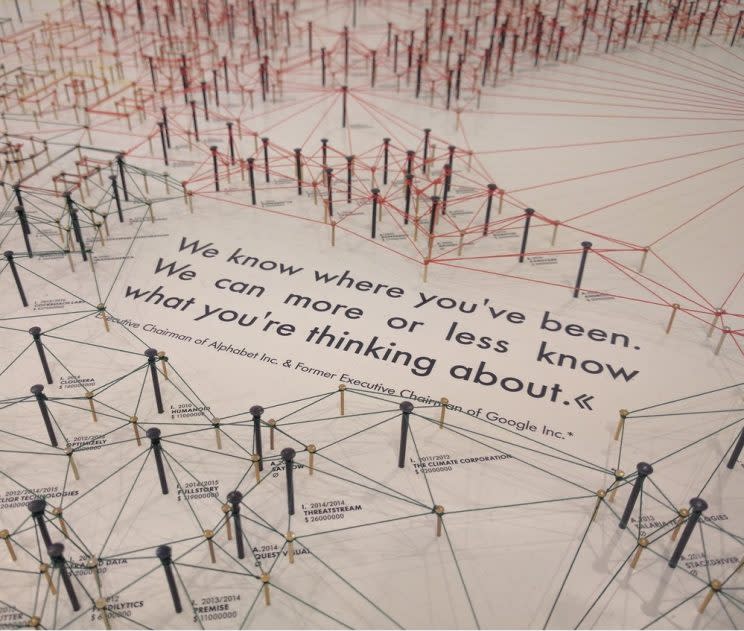The Glass Room shows how little privacy we really have

Shopping in the hip neighborhoods around lower Manhattan usual involves spending too much money on a designer shirt or handmade satchel, but a temporary location opened by the nonprofit behind the Firefox web browser, offers a different product: privacy shock.
The Glass Room, open through Dec. 18 at 201 Mulberry Street in New York’s Nolita neighborhood, is the product of Mozilla and the Berlin-based activist group Tactical Technology Collective. The two groups opened the shop with funding from from George Soros’s Open Society Foundations and eBay founder Pierre Omidyar’s Omidyar Network, to get holiday shoppers to think, not buy.
After a visit in early December, I can attest that the Glass Room succeeds in that mission. It’s also surprisingly amusing when not scaring you.
Art in the service of anxiety
The first thing you see when you walk into the Glass Room is a whimsical display by Surya Mattu and Tega Brain called “Unfitbit.” The exhibit encourages you to fake out a Fitbit by strapping it to a metronome to win health-insurance discounts.
Aram Bartholl’s “Forgot your password?” consists of a series of large bound volumes that contain 4.7 million LinkedIn passwords leaked in a 2012 data breach, printed out in alphabetical order. On the page I opened, passwords containing “crab” spanned 21 lines.
Things take a darker turn in Sam Lavine’s “Online Shopping Center,” an interactive setup that asks you to put on a brainwave-sensing headband as you are asked first to shop online from a selection dominated by industrial supplies and sex toys, then to contemplate your demise.

At that point the screen goes blank to display which of two possible thoughts the headband picks up each second: “You are shopping online” or “You are thinking about your own death.” A “Normal is Boring” series of works by Tactical Tech and an artists’ group called La Loma takes a whack at some of the companies that dominate the tech industry.
For instance, a tabletop-sized infographic made up of pushpins linked by yarn called the “Alphabet Empire” portrays the vast scope of Alphabet, Inc’s. (GOOG) holdings and investments beyond the core Google search engine.
Tracking tech
A separate collection provides real-world examples of how technology lets us take a microscope to each other. What looks like a standard employee badge turns out to be a Humanyze “Sociometric Badge.” Employers can use these to track who goes where in the office to get a sense of how well everybody works together.
Churchix facial-recognition software for churches—that, apparently, is a thing now—lets congregations track their members’ attendance at services not just as raw numbers but by their names. A monitoring system called Silver Mother lets you check up on an older loved one with a variety of sensors placed around their residence.
A tablet shows mugshots generated by Parabon Snapshot’s “DNA phenotyping” software; the sample images I saw generated from DNA samples were impressively close to actual photos of these suspects. Meanwhile, a large screen on a nearby wall shows metadata such as network addresses and device IDs collected from users smartphones and tablets as they pass by on the sidewalk outside.
Teachable moments
The Glass Room also offers tech support in the form of a “Data Detox Bar” at the back of the room. The expert who looked at my scruffy-looking MacBook Air approved of my use of Apple’s (AAPL) FileVault encryption and a password-manager service (in my case, LastPass). But he advised that I do all my browsing over a virtual private network and think about adding a screen filter to stop people near me from peeking at my work.
I took a “Data Detox Kit” from the bar, a set of cards with privacy exercises to do over the next eight days. Not all of it was helpful. Its day-one assignment to clear your browser’s history and cookies will screw up saved web site logins, and you can accomplish its intended goal of getting sites to treat you as a stranger by opening a private or incognito window.

An adjacent room hosts talks and workshops. On the evening I visited, privacy activist Matt Mitchell took attendees on a tour of surveillance and policing technology used around New York, now and in history. Mitchell explained how much of today’s surveillance involves the automated collection of data — for instance, by license-plate readers attached to streetlights — without clear rules governing how long the police can keep that data.
It was an enlightening experience, one I haven’t shared with that many others. Mozilla chief marketing officer Jascha Kaykas-Wolff said in an email forwarded by a publicist that about 6,000 people had visited through Tuesday, and that the total might hit 10,000 by the time the Glass Room closes Sunday night.
That’s not a lot. But if each of those 10,000 or so people uses the right clickbait headline to share their experience on one of those privacy-robbing social networks, we’ll be getting somewhere.
More from Rob:
Email Rob at rob@robpegoraro.com; follow him on Twitter at @robpegoraro.


